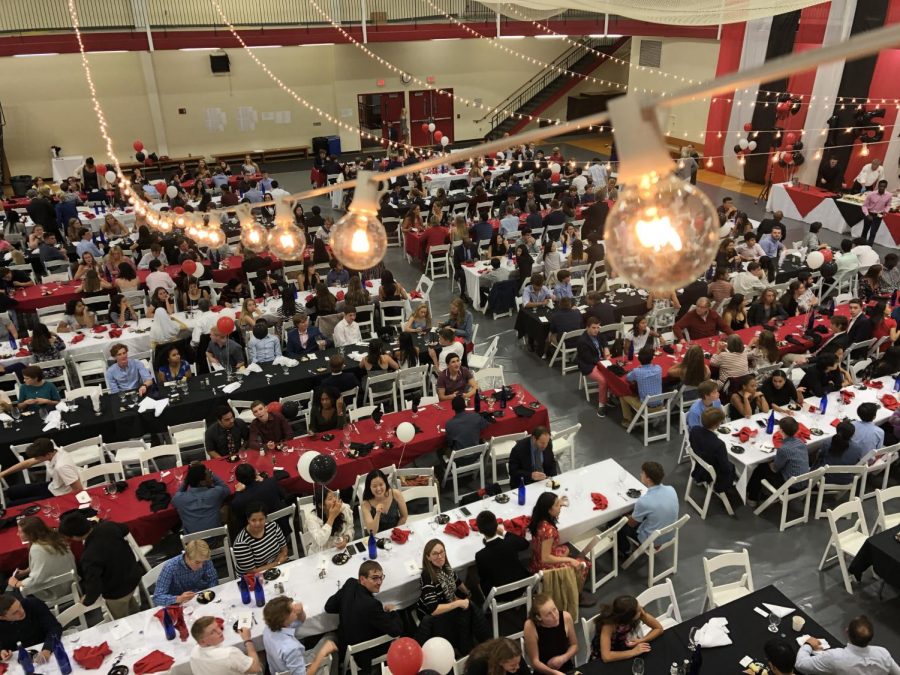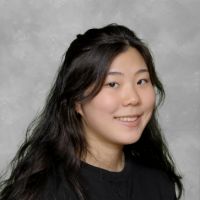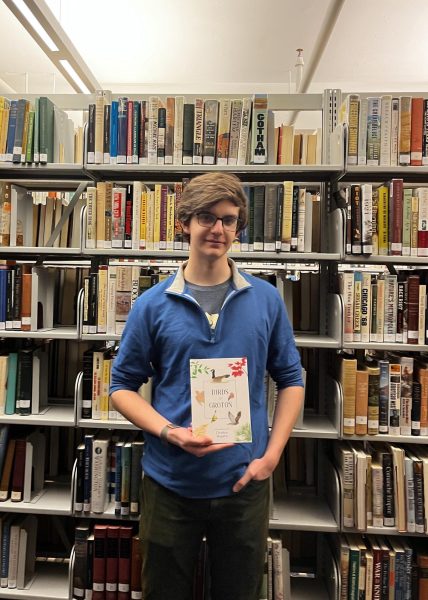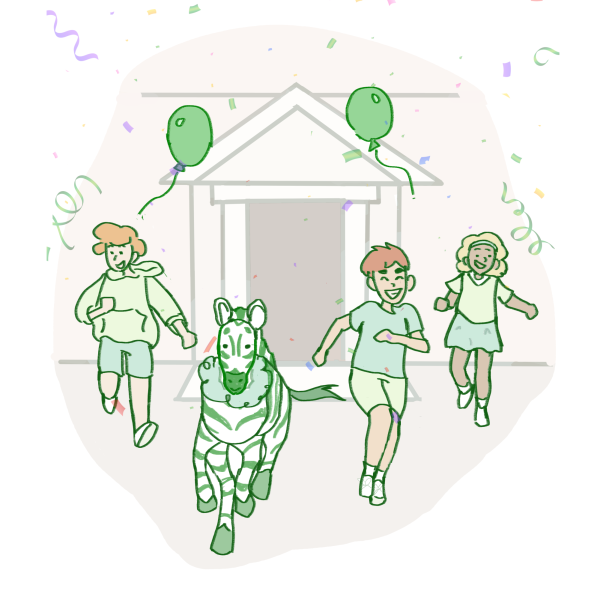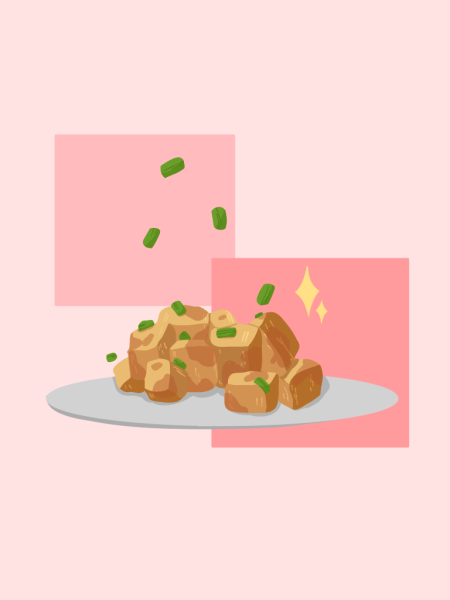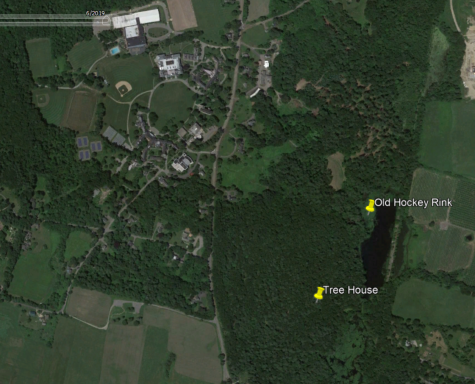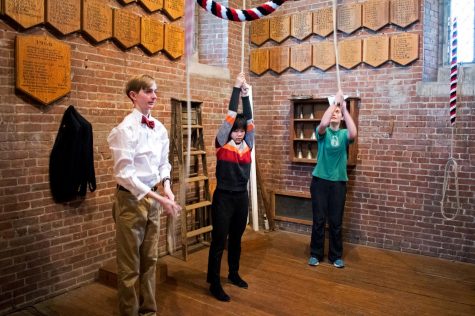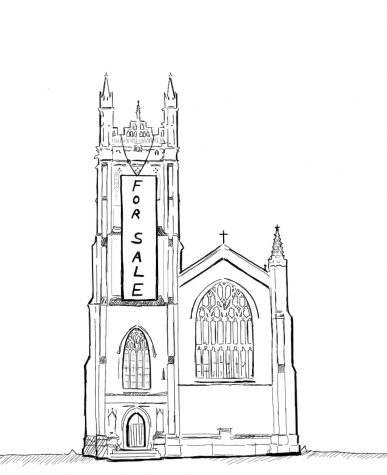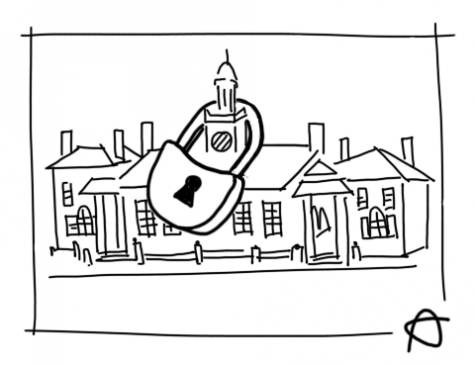Looking Back at Groton’s 135 Birthdays
Despite many changes that have taken place, it is still Groton tradition to celebrate the school’s birthday with much pomp and grandeur.
26th of October 1885: Groton School’s first anniversary. Being the first ever celebration, the boys had no precedent of hosting birthday feasts and the day was shrouded in mystery. Tea was served half an hour earlier, and vicious rumours swirled around the school that this time shift would be a permanent change, and that half an hour would be added to evening study hall. After tea, the boys headed to supper, and were greeted by a lighter meal than usual. Every boy’s face wore an expression of despair. The boys begged the masters to elaborate on the peculiarities of the day, but they stood firm and refused to give a definite answer. The boys miserably went off the study hall, trying to work in spite of their growling tummies. When study hours ended, Rev. Peabody, preceded by the prefects, entered the room. There was a moment of ominous silence. Then Rev. Peabody announced that the school’s first birthday would be commemorated by a supper in the dining-room (Now the Old Library).
The hungry boys found a repast of oysters, ice cream, cake and sundry. “The scene was delightful,” says the article in Vol. I. No. 6. Of The Grotonian. The candles on the cakes twinkled, the magnificent wreath of ruddy oak leaves stretched across the wall, and there was a “gleam lit” fireplace, giving the entire room a glow of festivity. Mr. Gardner also came up especially for the event, adding to the delight of the boys. The pupils stuffed as much food as they possibly could, and there was particular concern for the boy sitting on the right of Mr. Billings, the classics master, who “certainly would have experienced sudden explosion if he continued for much longer”.
Following the dinner feast, Rev. Peabody called upon the Groton Quartette (J. G. Gilpatric, the music master, first bass; N. T. Robb ’89, tenor; D. C. Chauncey ’87, baritone; E. S. Mullins ’89, second bass) to give the school a song. The Quartette was somewhat embarrassed as they were unprepared, but they rendered the classic “Muldoon”. C. R. Sturgis ’89 followed with the “Midshipmite,” and J. C. Hoppin ’88 with the “Quilting Party”. Several boys then made speeches, the authors were imbued with much disregarded maxim that night, and they say brevity is the soul of wit. The choir sang their glee afterwards followed by the entire school joining hands to sing “Auld Lang Syne”. The boys roused three cheers for the school and three more for Mr. and Mrs. Peabody. Finally, the birthday came to an end.
Squibs were another essential part of School Birthday evenings during the days of Mr. Peabody. Squibs were humorous skits imitating faculty members put together by the Sixth Form. The new kids, or “newks” as they were called, were often told that they would be called upon to speak during squibs. Pale and with faltering steps, the newks came to squibs, usually to be told with great amusement that they had been tricked, and that no speech would be asked of them. A Groton Legend has it that a certain new master, Mr. Jones, was told he would have to give an impromptu lecture at squibs. Trembling with fear at the thought, Mr. Jones took the next train home. The following day, Mr. Peabody received this note:
Dear Sir:
I am very sorry I was unable to say good-bye to you yesterday, but I was in a great hurry to catch my train.
Sincerely Yours,
Mr. Jones
Before bed on School Birthday nights, the boys couldn’t be snuggled in to sleep before a nice film. The film selections were particularly exciting on the evenings of the School Birthday. For instance, in 1957, the film was “Joe Butterfly,” a rare occasion in which the film was in colour. In 1958, the school showed a brand-new released film, “Tale of Two Cities,” starring Dirk Bogarde and Dorothy Lutin. Some international selections were shown as well. On the 76th birthday, “My Uncle,” a French comedy about a French family in a large, modernised French city, was shown.
On the 100th anniversary of Groton in 1984, there was a massive firework display, and huge tents, even larger than the ones we have on Prize Day. “Hundreds of alumni came back to the Circle,” said Mr. W. Polk ’58, former headmaster of Groton School. Celebrating the school’s centennial, a picture book containing photographs that were taken that day, along with others, were put together by Mr. D. Brown ’57 and published. Mr. Brown recalls that there were two birthday celebrations that year, just because everyone wouldn’t fit into one place. “The students had supper on Friday evening at the Scott Rink, and the alumni came back on Saturday evening where there were many dignitaries including Louis Auchincloss ’35, who gave a speech regarding his time at Groton and the philosophy of its founding.”
Sometime during Mr. Crocker’s time as a headmaster, traditions changed so that the school birthday was a holiday; students had no classes. There was a customary steak dinner and teachers usually led students to some sort of excursion. For instance, on the 71st anniversary in 1955, a group toured the Champion International Paper Co. Mill at Lawrence, the mill that produced all the paper for National Geographic. Others had the bright idea to bring out the canoes and ventured up the Nashua and Squannacook Rivers to West Groton. Mr. T. Gregory ’62, reads out from his 1958 Third Form Weekly, “masters take boys for some mountain climbing and hiking in New Hampshire.” The tradition of having a normal school day on the School Birthday seems to have been changed around 1967, on the 83rd birthday.
Another distinct feature of School Birthdays was distinguished alumni invited back to the Circle to give a talk. Before Hundred House had dormitory units installed, the interior was shaped as a very long corridor. On the evening of the School Birthday, many graduates would return to the Circle. Before heading to dinner, the entire school lined up in this particular order: the graduates from oldest to youngest, the faculty, and the students by oldest form. Then, they would all sing the song, “John Brown’s Body”, which is a song about John Brown who was an abolitionist with wild, scruffy hair. There wasn’t a particular reason as to why this song was sung, “It was just one of those crazy traditions,” chuckles Mr. Brown. They would sing the refrain again and again until they entered the dining room. When the new Dining Hall was built sometime between 1963 and 1964, there were no more hallways to do a procession, and the tradition stopped.
A tradition that did continue for a while was the ivy wreath. There used to be loads of ivy around the buildings and the headmaster’s wife would gather several schoolboys to collect strands of ivy. At the supper table, they would each place the ivy on their dinner places and weave wreaths for the masters sitting at the ends of each table. This tradition dissipated in the 1960s when all the ivies were removed from the school buildings as they were detrimental to the brickwork.
In more recent years, “A particular tradition that stands out in my memory is the singing of the song ‘Blue Bottles,’” says Mr. H. Mumford ’09. For those unfamiliar with the tradition, the Sixth Form shouts to the Fifth Form, “We want blue bottles!” and the Fifth Form sing the song in front of the entire school, counting down the number of blue bottles depending on how old the school has turned that year. The song is always conducted with a carving knife by a faculty member who is a graduate of the school. According to Dr. A. Reyes ’80, Mr. William Amery Gardner began the tradition of conducting with a steak knife, as back in the day, meat was not cut in the kitchen and faculty members would carve fish and meat at the dining table.
Many have inquired why “Blue Bottles”? According to Mr. Brown, the first mention of the song was sometime in the 1890s, when the school was about 15 years old. As there were no radios, televisions, or movies, boys sang songs to keep themselves entertained. “Blue Bottles” happened to be a popular tune back in the day, and someone from the Fifth Form randomly stood up and sang the song during the evening festivities after dinner. A former faculty member, Mr. H. Richards, wrote A Schoolmaster’s Scrapbook in which he traces the origins of the song all the way to the South, to a mountainous region called the Ozarks that spreads across Missouri, Arkansas, Oklahoma, and south-eastern Kansas. “Blue Bottles” had originally been folk music, a song sung by people who lived off in the woods and mountains.
This year, on the school’s 135th birthday, Naa-Sackle Akuete ’04, the CEO of Eu’Genia Shea and President of the Global Shea Alliance, spoke in Morning Chapel. She gave an inspirational talk about her business and the school motto, cui servire est regnare (to serve is to rule). In addition to Ms. Akuete, the school welcomed back other alumni in time to celebrate the birth of our beloved school.
It is interesting to see different traditions evolve throughout the years. Unfortunately, our dinner menu’s been downgraded from the customary steak ones. When asked to recall the menu, “Definitely broc-chic,” replies Ms. R. Hartmeyer ’09. “But we did have little ice cream cakes that were fantastic,” adds Mr. A. Santry ’12. Although the iconic ice cream cakes wasn’t there this year, the new pastry chef’s massive cake with zebra patterned icing and a shield shaped cake on top received positive reviews. “The cake’s been very well baked. It’s just the right texture,” said Nicole Lee Heberling ’21 during the sit-down dinner.
As Mr. Polk once said in his speech on the 125th birthday of the school, “Hope is the quality at the heart of Groton School that brings us graduates back here, if mind if not in body, again and again, as a touchstone for our lives.”
(Special thanks to Mr. Tod Gregory ’62, Mr. William Polk ’58, Dr. Andres Reyes ’80, Mr. Douglas Brown ’87, Ms. Naa-Sackle Akuete ’04, Ms. Ripley Hartmeyer ’09, Mr. Henry Mumford ’09, Mr. Arthur Santry ’12)


